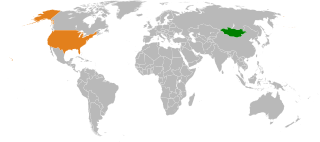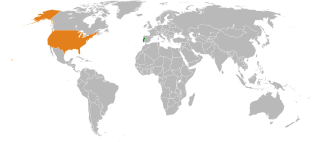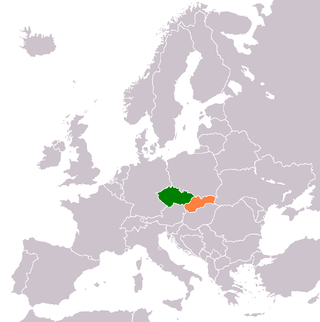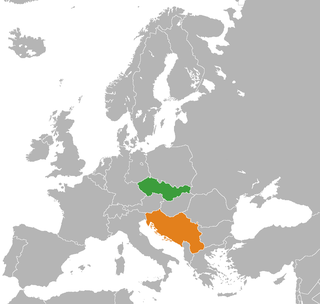
The Czech Armed Forces, also known as the Czech Army, is the military service responsible for the defence of the Czech Republic as part of the Armed Forces of the Czech Republic alongside the Military Office of the President of the Republic and the Castle Guard. The army consists of the General Staff, the Land Forces, the Air Force and support units.

The Czech Republic is a Central European country, a member of the European Union, the Organisation for Economic Co-operation and Development (OECD), Organization for Security and Co-operation in Europe (OSCE), the North Atlantic Treaty Organization (NATO), the United Nations. It entertains diplomatic relations with 191 countries of the world, around half of which maintain a resident embassy in the Czech capital city, Prague.

The Armed Forces of the Slovak Republic were divided from the Czechoslovak Army after dissolution of Czechoslovakia on 1 January 1993. Slovakia joined NATO on 29 March 2004. From 2006 the army transformed into a fully professional organization and compulsory military service was abolished. Slovak armed forces numbered 19,500 uniformed personnel and 4,208 civilians in 2022.
The Slovak Republic has been a member of European Union since 2004. Slovakia has been an active participant in U.S.- and NATO-led military actions. There is a joint Czech-Slovak peacekeeping force in Kosovo. After the September 11, 2001 Terrorist Attack on the United States, the government opened its airspace to coalition planes. In June 2002, Slovakia announced that they would send an engineering brigade to Afghanistan.

Foreign relations of Sri Lanka refers to the diplomatic and commercial relations between Sri Lanka and other countries. Sri Lanka has stressed its principle of "friendship towards all, enmity towards none" in its diplomacy.

Relations between the Czech Republic and the United States were officially established in 1918, but has been cut throughout the history, exactly between 1948-1989 when the Czech Republic was under the soviet influence.

Finland and the United States currently have good relations. The United States recognized Finland on May 7, 1919 after it declared independence in 1917, and officially established diplomatic relations in 1920. Due to World War II and Soviet pressure, relations were suspended between 1942 and 1945 before being raised to embassy level in 1954. Finland has been of strategic importance to the United States due to its position bordering the Soviet Union and later Russia, and after the end of the Cold War in 1991 Finland's shift to the West has led to warmer relations. There is significant trade activity, including military procurement, between the two countries.

According to the 2014 census, there are 37,241 Moldovan-Americans residing in the United States.

Bilateral relations between Mongolia and the United States formalized in 1987 with the establishment of diplomatic relations. Since then, the United States has become a key third neighbor to Mongolia, and in 2019 this relationship was upgraded to a strategic partnership. Ties focus on education, development assistance, and defense.

Portugal–United States relations are bilateral relations between Portugal and the United States.

Relations between Romania and the United States were formally established in 1880, with the appointment of Eugene Schuyler, a renowned and talented diplomat and historian, as the first American diplomatic representative to Romania. After Romania left the Eastern Bloc in 1989, US-Romanian relations have matured into a strategic partnership that encompasses a wide range of political, military, economic and cultural issues. The US supported Romania's entry into NATO, setting the stage for further integration into Europe. Today, Romania is a strong ally of the United States, and the two countries work together to build democracy, fight terrorism, and promote regional security and stability. United States is Observer bureau of the BSCE and both countries are Observer bureau of the CBSS.

Czech Republic–Russia relations are the bilateral foreign relations between the Czech Republic and the Russian Federation. Relations have substantially deteriorated in recent years due to events such as the Russian annexation of Crimea in 2014, Russian sabotage of Czech ammunition depot in Vrbětice in 2014, poisoning of Sergei Skripal in 2018 and Russian invasion of Ukraine in 2022.

Czech Republic–United Kingdom relations are foreign relations between the Czech Republic and the United Kingdom. The Czech Republic has an embassy in London and four honorary consulates. The United Kingdom has an embassy in Prague.

The Czech Republic and Slovakia established diplomatic relations on January 1, 1993. The Czech Republic has an embassy in Bratislava. Slovakia has an embassy in Prague. Both countries are full members of the European Union and of NATO.

The nations of the Czech Republic and Mexico established diplomatic relations 1993. Relations between both nations existed beginning in 1922 when the Czech Republic was part of Czechoslovakia until its separation from the union in 1992.

The American Czech and Slovak Association (ACSA), originally American Czechoslovak Society (ACS), was a Washington, D.C. based national organization with a mission to facilitate contacts and cooperation between people, institutions and organizations in the United States and the Czech Republic and Slovakia, and assist in the transition to democracy and market economy in Czechoslovakia after the Velvet Revolution, which ended Communist rule in the country. It was founded in 1990, and in 1994 it served as a foundation for the new American Friends of the Czech Republic (AFoCR).

The nations of Mexico and Slovakia established diplomatic relations in 1993. Relations between both nations existed beginning in 1922 when Slovakia was part of Czechoslovakia until its separation from the union in 1992.

Czechoslovakia–Yugoslavia relations were historical foreign relations between Czechoslovakia and Yugoslavia, both of which are now-defunct states. Czechoslovakia and the Kingdom of Serbs, Croats and Slovenes were both created as union states of smaller Slavic ethnic groups. Both were created after the dissolution of Austria-Hungary, itself a multinational empire unable to appease its Slavic populations or implement a trialist reform in its final years.

Relations between Czechoslovakia and the United States refer to two periods in Czechoslovakia's history. The first being the establishment of Czechoslovakia after its declaration of independence in 1918 from Austria-Hungary initiated by President Woodrow Wilson as part of his Fourteen Points following World War I. The second period being the communist era from 1948 when relations were strained, until 1992 when Czechoslovakia split forming the independent nations of the Czech Republic and Slovakia as a result of the 1989 Velvet Revolution.





















